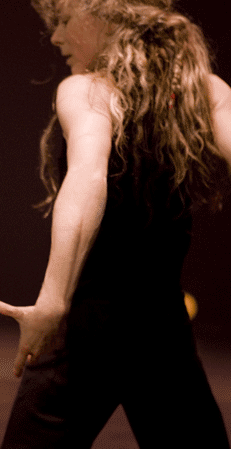Louise Lecavalier and Fou Glorieux

Children and A Few Minutes of Lock
Looking back at my notes from the last time I saw Louise Lecavalier dance, I am reminded that I compared that piece, Cobalt Rouge to Salvador Dali on speed. In other words, Lecavalier was the technically gifted and highly expressive dancer that she always is, but I found that piece to be somewhat inaccessible. So, I was a bit hesitant when it came to seeing Children and A Few Minutes of Lock as presented by Dance House on November 4th and 5th at the Playhouse Theatre. This time around, Louise Lecavalier remains, now in her early 50s, an icon of excellent dancing, only in these pieces the dance vocabulary is a much more accessible, though not a trite, example of choreography that was at times beautifully expressive, at moments humourous, and occasionally contained a dramatic urgency
Of the two pieces, A Few Minutes of Lock, choreographed by Édouard Lock, was by far my preference. It was a graceful, and too short duet between Lecavalier and Keir Knight, that also included the participation of Patrick Lamothe, who danced in the first piece, Children. This sinewy, precise work was danced to a warmly rhythmic guitar piece that repeated the same bars over and again while Lecavalier and Knight took up the whole of the sparsely lit, undecorated stage in a duet that suggested a deep and tender relationship between the two dancers. Lecavalier is a tremendously strong, and lithe dancer whose gestures are bold, and demanding of her partners. In the case of A Few Minutes of Lock, I found that Knight’s abilities were well matched to hers, even if he didn’t quite get to demonstrate the full spectrum of his skill. This, however, was welcome respite from the previous piece in which I felt that Patrick Lamothe was so poorly cast for the duet with Lecavalier.
Throughout the fifty minutes of Children, I kept wondering why Lecavalier would partner with Lamothe: his dancing style seemed so uncoordinated with hers. Where she is immensely flexible, he seems limited; where she is precise and nimble, he seems clumsy; and where she is graceful, his movements come across as laboured, even untrained at times. There were moments where their unison was off, and times when I even felt like Lamothe was watching Lecavalier for his cues. If he was just having an off night, it’s a shame because the result made me think of a protracted re-enactment of Beauty and The Beast, only this beast never got to transform.
The choreography itself went through several transitions from quickly urgent to two stepping country to a slightly macabre and humourous moment when pillows, that seemed to be stand-ins for babies, got tossed about, one of them landing up in the lap of an audience member. I found the numerous switches in tempo and tone made it hard to engage fully with any one scene, and I also had a hard time relating to this piece as a whole, but within it, there were certainly moments of rich imagination and grace that I enjoyed.
Seeing Lecavalier dance reminds me why she has a place in Canada’s pantheon of great dancers. Even partnering with someone so much less skilled than she, Lecavalier displays her exceptional grace, strength and creativity - things that are perhaps best wrought over many beautiful years on stage.



